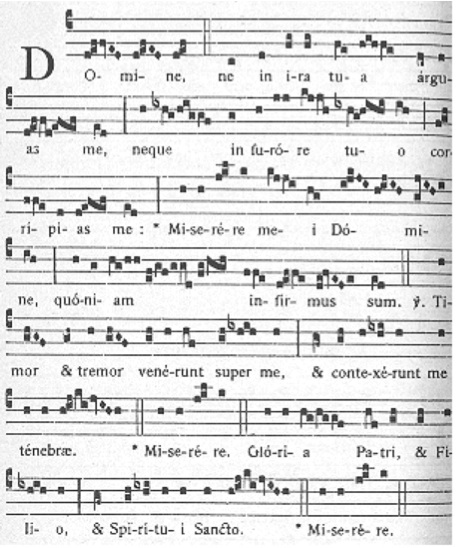
What is the short responsory?
There are two types of responsories that are used in the Office - the 'prolix' responsories of Matins, also used at I Vespers of major feasts by some monasteries; and the short responsories (responsoria brevia) of Lauds and Matins.
The key challenge in saying the responsories is that while the form of the short responsory is written out in full for Sunday Lauds (MD 52), after that they are only provided in abbreviated form, so if you want to say Lauds and Vespers you need to learn how the responsory works.
The structure of the responsory
If the normal responsory for Sunday Lauds was summarised the way it usually is in Office books it would look like this:
R Inclina cor meum, Deus, * In testimonia tua. Inclina. V Averte oculos meo ne videant vanittem, in via tua vivifica me. In testimonia. Gloria Patri. Inclina
The red letters are cues to remind you that you need to fill out the text.
In chant books, as the illustration above shows, only the parts with separate chants are normally written out in full.
But from the abbreviated version provided above:
R Inclina cor meum, Deus, * In testimonia tua. Inclina. V Averte oculos meo ne videant vanittem, in via tua vivifica me. In testimonia. Gloria Patri. Inclina
What is actually said is:
Inclina cor meum, Deus, * In testimonia tua.
Inclina cor meum, Deus, * In testimonia tua.
Averte oculos meo ne videant vanittem, in via tua vivifica me.
In testimonia tua.
Gloria Patri et Filio et Spiritui Sancto.
Inclina cor meum, Deus, * In testimonia tua.
Saying the responsory
In private recitation, you sing or say the whole thing, including all of the repetitions. But it actually makes more sense when you think about how it is performed in a monastery.
The Respond
In a monastery, the opening line (respond) is sung by the person leading the Office for the day (hebdomadary), the whole line is then repeated by everybody:
Inclina cor meum, Deus, * In testimonia tua.
The Verse
The person leading the Office then sings the verse:
Averte oculos meos, ne videant vanitatem: in via tua vivifica me.
The respond
Everyone then replies with the second half of the first line:
In testimonia tua.
The short doxology
Then a short doxology (note that the normal followup verse Et in saecula...is not added) is sung by the person leading:
Gloria Patri et Filio et Spiritui Sancto.
The Respond again
Everyone then responds by repeating the whole of the first line (Inclina cor meum...In testimonia..).
Where to find the responsories
The 'default' responsories for Lauds and Vespers for Sundaysand weekdays throughout the year are included in the psalter section of your Office book.
These responsories are, however, often displaced by those for feasts or seasons, found in the 'sanctoral', Commons, or 'temporale' sections of the Office books.
In some cases, such as Octaves of a feast, the Antiphonale Monasticum provides a slightly more elaborate version for use at I Vespers of the feast, and then a ferial version for use throughout the week.
The chants currently employed for the short responsories are very simple, usually employing only around three standard formulas, and so can easily be learnt.
Practice
You can check your understanding of how to read the cues in your Office book by looking at the text for Lauds for Christmas in the Diurnal (MD 72*) (Verbum caro). Write out the responsory in full, then cross-check what you have written against the recording below.
(Nb if the recording is not accessible in your location, write out your answer and put it in the comments box if you'd like me to check it).
SUMMARY
Short responsories are
used at Lauds and Vespers.
Office and chant books
typically do not write out the responsories in full, so you need to learn how
to expand the cues given.
The basic format of the
responsory is:
Respond
(said twice in full)
Verse
Second
half of the respond
Short
doxology
Respond
And for the next part in this series, continue on here.
